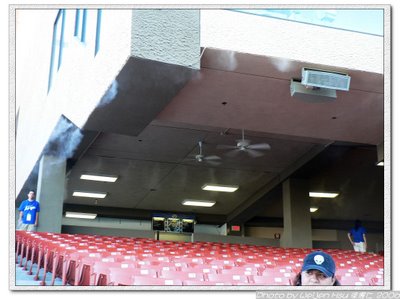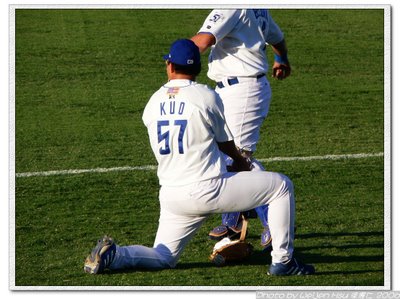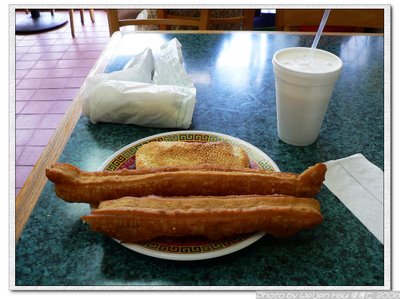Some people believe that one cannot have a complete Vegas experience without gambling. Others believe in order to have the best deal available from Vegas, one should stay away from gambling as much as possible. Whichever of the above you agree with, there is no denying that gambling is one of the distinguishing factor of the city. It is just impossible to walk about the city without noticing it.
When it comes to gambling I am more of a theorist than a practitioner. I like to read and think about gambling. I read related websites and books when I have some leisure time. I do this partly because gambling is closely related to probability, my favorite mathematical subject, and partly because it is very enjoyable to read about the war between gamblers and casinos. It is absolutely thrilling to read about how a group of smart people trying to hack and gain the slight edge against the well-designed rules of games through careful calculations, and how the vulnerabilities in the rules get patched by another group of smart people, without making the game too complex to lose the public interest. The intellectual competition between the professional gamblers and the casinos is really fascinating to read. However, I did not try out the techniques used in these books and websites extensively myself, mainly due to the lack of time to practice and carry them out in the field.
But I do have some thoughts and observations about gambling. If you do not like long articles, you can fast forward to the conclusion and see what I need to tell you before you fall victim to the well-prepared casinos.
Gamble seriouslyIt is the best to open my article with a quote from a book I read:
"There is an extraordinary and interesting dichotomy in the ways gambling is perceived. To the tourist and the gambler, gambling is all about luck. To those in the business, gambling is about mathematics. To the visitors, gambling is a few hours a day, while to the casinos, gambling is 24 hours a day, every day. The gambler hopes to walk away with a fortune, but the casinos know that in the long run that fortune will belong to the house. To visitors, gambling is recreation combined with risk and chance. To the casinos, gambling is business combined with near certainty." -- From the Unofficial Guide to Las Vegas 2006, by Bob Sehlinger, page 270.
Well, sound a bit too serious, is it? It is easy to be tricked by the amusing and relaxing atmosphere in the casinos, with all the lights blinking, sounds beeping, and people cheering. It is easy to lose sight that you are dealing with very well-prepared people who have successfully built a huge revenue to support the whole business which in turn supports the growth of the capital of gambling. The fact is, if you take gambling lightly, the casinos will be more than happy to remove the hard-earned money from your pocket and secure it safely in their vaults. Although I have never seen it myself, I am pretty confident that they have enough space in the vaults for as much as you are willing to wage. So my first suggestion, and the most important one, to you is that you have to take gambling seriously. You need to know exactly what you are doing when you gamble. Don't gamble randomly because it seems fun. You are unlikely to get anything out of it without doing the homework first.
If I have convinced you, let's get serious about gambling now. I will briefly show you how you should plan for your gambling activities to avoid some common pitfalls. It is not very deep mathematics, and if you have learned some probability probably you already know all these. However I think it deserves some space on the blog.
Worst sin in gamblingLet me first tell you what is the worst sin in gambling you should definitely avoid. Well, if you are against gambling, you may think it is a sin in itself. I am not going into that here. Assuming that you gamble, what is the worst way to do it?
Of course the rule of thumb is one should never gamble with the money one cannot afford to lose. Before you go to the casino, set up a number that you can afford to lose, while you are still rational. No matter what happens, don't go beyond this limit. In particular, don't try to win your lost money back by putting more than you can afford to lose into the game. DON'T GO BEYOND THE LIMIT YOU SET. Period. If you think you cannot do this, don't gamble. This is not the game for you.
But it does not mean if you have some spare money to put at stake to try your luck, you can gamble with the money in any way you like. It makes a huge difference how you play with it.
During my two short stays at Vegas, I have seen many people made the same mistake. From time to time, I see people sit down at the table, exchange a 20-dollar bill into chips, and start putting down 5-dollar bids. "NO!!" I almost couldn't hold back my voice when I saw it for the first time, "You are GIVING THAT MONEY AWAY!!" But I become numb about that after I sit there for one hour or two. Most of the time, those people lose the chips and walk away with a oh-gash-I-have-lost-20-dollars-in-5-minutes-grrrrr-this-game-sucks look on their faces, even before I can tell whether they play smartly or poorly. The mistake here is, if you don't budget your money carefully, you lose it easily.
This is related to a classical probability exercise problem known as "gambler's ruin". The set up of the problem is as follows: A gambler starts with a budget of K dollars in the pocket. In each game, he gambles with one dollar and either wins (with probability p) or loses (with probability 1-p). The budget either increases or decreases by one dollar per game. The gambler stops only when he goes broke (loses all the money) or reaches a goal (N dollars, N>K). In the probability textbooks, usually they ask you what is the probability for the gambler to achieve his goal.
I am not going to talk about how to solve the problem in detail (if you are interested you can check out some
probability textbooks), but hopefully you have already observed what is the mistake in the scenario I mentioned earlier: With a 20-dollar budget, 5-dollar bid is way to large. It takes only four straight loses to lead you to broke. Even if you are talking about a fair game, in which you win half of the time and should never be offered if the casino wants to stay in business, the losing streak that wipes you out of the game happens with one sixteenth probability. With a slight misfortune, you are done and gone. If it is your money at stake, I hope you would think twice before putting down your bids. You should not lend you at a starting point that close to broke from the first place. You have perfect freedom to pick the budget size and the bid size, so why do you put yourself in a danger position while the casino already has almost all the advantages they can think of well-placed in the rule book? Give yourself a break by allowing enough buffer from the broke point so the short-term misfortune cannot jumps and bites you. The general guideline is you should allow at least twenty times the bid size as your budget. If you have 20 dollars to work with, you should not bid more than 1 dollar each time. If you want to play with 5-dollar bids, you should be prepared with 100 dollars in your pocket. This buffer space will hopefully prevent you from falling victim of the worst sin in gambling, under-budget, and make you stay in the game long enough to at least have some feeling of playing the game instead of being quickly robbed and regretting about the lost money you cannot (and SHOULD NOT! DON'T GO TO YOUR POCKET FOR THE MONEY YOU DID NOT PLAN TO PUT INTO PLAY!) do anything about it now.
There are many ways to enforce the budget limit, and the easiest way I recommend is to exchange for the exactly same amount of chips or tokens when you start, and never lay your hand on the wallet until you finish for the day. Some people prefer to exchange for small amount of chips at the beginning, and get more when needed. The bad thing about this is it builds up the tendency of reaching into the pocket every now and then. It is very likely to lose count of how much you wage while you concentrate on playing, and it takes extreme self-discipline to avoid going over the boundary when taking money out of the pocket becomes a natural move. By exchange once for all you eliminate such possibility.
Of course, with a large budget you still risk losing all of it. Keep that in mind, it is gambling we are talking about, isn't it?
Setting up a GoalSetting the budget size and the bid size is only half of the story. What is equally important is to set up a reasonable goal to stop gambling. Most casual gamblers come to the casino with some money they are willing to spend on gambling WITHOUT even thinking about the goal. They just keep gambling until they reach the goal casinos set up for them: Losing all the money they put into play. The mathematical explanation behind it is, if you solve gambler's ruin problem with the goal N set as infinite (That is, you don't have a specific goal so you will keep gambling no matter how much you win), you WILL end up losing all your money, regardless of what budget or bet size you use, and what the winning probability of each game is. The casino have as many chips as you can win - If they run out of it at the table they have plenty more in the vault - so even if you are lucky enough to keep winning, you don't have a stop point to cash out your chips unless you set up one for yourself. If you don't stop properly, eventually the wind changes direction and you lose the chips the casino lend you temporarily back to them. You gotta set up a goal for yourself and cash out when you reach the goal, otherwise you NEVER win.
This is easy to say but very hard to do. Who will quit when he is still winning? Actually, this is the very concept that casinos rely on to make a good fortune: Those who are under-budgeted fall to short-term misfortune. Among the well equipped, some of them are lucky enough to win but cannot stop while they are winning, hence eventually few keep the money they temporarily have at hands. Further more, they design the rules carefully so in the long run they are the winning side. Perhaps the following concept can help you a little bit: When you win gambling, the tokens at your hand symbolize YOUR money. They are equally valuable in any sense as your hard-earned money from your work, whatever it is. Don't think it as the "extra money" you can again gamble with. This is exactly the mind set with which you cannot win.
Having said that, I also have to admit I was not able to do it myself, therefore I ended up break even during my both stays at Vegas. I did win something but later lose the winning by not quitting. Ideally, the goal should be set up depending on how much risk you wish to take. For example, in a fair game (it does not exist in the casino, I can assure you again), if you start with K dollars and set the goal at 2K dollars, you end up reaching it or going broke equal-likely. The closer you set the goal to the initial budget, the more likely you can reach it. Check out the book "How to gamble at the casinos without getting plucked like a chicken" by James Harrison Ford to know more examples on setting up the budget.
And you should be aware of the following dilemma: You cannot maximize the play time and the likelihood of reaching your goal at the same time, given that the expectation is against you. In negative expectation games, if you want to stay in the game longer rather than get eliminated by the short-term misfortune, you should use a small bet size relative to your budget as I discussed previously. However, if you want the best shot to reach your goal of earning, you should use the largest bet size possible to reach that goal - Either you lose or win, you are done in one bet. The longer you linger in a negative expectation game, you fall victim to the Law of Large Number, which eliminates the possibility of short-term noise and converges your outcome to the long-term trend - Giving the money to the house - by the design of the rules. You have to choose which one you like better: the entertainment, or the money? If you consider gambling entertaining, then expect to pay some fees for that just like you do in any other entertainment, and by careful planning you can avoid paying unnecessary high fees. If you just want to try out your luck for the potential of increasing your pocket money, put everything you have in one shot. You are hurting yourself if you do anything else.
Choosing the right gameNow if you think you are disciplined enough to set up the budget and follow the plan, you can try gambling. However, there is another important decision to make: Which game should I play? Each game in the casino has different characteristics and you may prefer one over the others. However there is one commonality among the seemingly very different games: They are all carefully adjusted so the house has the edge over you, otherwise the game would not be there. That means, whatever you play in the long run you expect to lose.
However choosing a good game as opposed to a bad one still makes a huge difference. There are games in which the house edge is minimal, even less than 1%. With some luck it is possible to obtain some short-term winning, and hopefully you know when to stop and keep the money as your own. My general guideline for this one is: Play some game that requires you to use a strategy. The reasons are: (1) For these games the casinos can rely on those who are not playing the best strategy to make the money, so the rules are not as bad as those of games that do not require a strategy. (2) For the games that require a strategy there is fun involved in learning the best strategy and thinking about why the strategy is good. You can find yourself playing better as you become more experienced. For the games that depend solely on luck, such as roulette, you do as well as the novice even if you play the game for 30 years. That is time well-wasted for me. If you have the same geek background as I do (I am referring to you, EE/CS majors!) and want to play a game that solely depends on luck, just code up a random number generator with fancy graphic interface and play with it at home. It will save you money, believe me.
I mostly play Blackjack when I gamble. Of course, partly because I have heard about the legend how a group of MIT students won a huge money over the casinos, and also because Blackjack is a well-researched game so a lot of information is available on the Internet (check out the references). In Blackjack there is something called basic strategy - a set of proper responses in various situations. It is generally believed that if one plays proper basic strategy, the house edge is less than 1% - for every 100 hand of cards played, you expect to lose the bid size of one hand - which is good enough if you want to experience gambling and willing to lose a bit of money as the fee for the entertainment.
There is some trick called card counting in Blackjack. The basic idea is that when the game is played, the cards are continuously removed from the deck and the composition of the remaining cards changes, and this posts influences on the odds in the subsequent games using the same deck. If one keeps track of the composition of the remaining deck and plays according to the odds, it is claimed by many professional gamblers that it is possible to turn the edge around. There are many variants of the ways you can count the card and plenty of references are available. For myself, I never mastered card counting, mainly because I would not spend time on training myself with a technique I rarely need.
You may doubt whether the fairy tales of people winning big money from the casinos with card counting are true. Well I tend to believe it as I have heard people I know personally doing it. I have a friend (Hereafter referred as
Friend to maintain anonymity) who is an amateur card counter. The
Friend has been to Vegas for more than ten times in recent years, and among these trips,
Friend never paid anything from the pocket. All the spending, including flight tickets, hotels, shows, meals, are paid by the money
Friend made from playing Blackjack. Sure, this is much less than the millions in the legendary book "Bringing down the house", but I think this is good enough for we amateurs. A free vacation at Vegas sounds good enough, so there is indeed some advantage of learning the trick. Of course, keep in mind there is nothing absolute in gambling. Even the professionals lose, so certainly you should not expect to win even if you learn the perfect techniques.
However, there is a problem. I would refer to the problem as the curse of the Information era. If you do a bit of study on the history of card counting, you will find out it has been around for some time. The root of the trick dated back to the 60s, but for a long time the secret is only known by some small group of people. Since the dark art is only performed by a few people, the casinos can live with the vulnerability in the rules and try to keep an eye on people who are aware of it, and evict them from the table promptly to control the loss. Rumors even say that there is a black-list of people who are forbid to play Blackjack in the casinos, compiled by the casinos. Of course, from time to time the casinos can fail to discover the card counters and remove them, and that's how the MIT people get famous. But not any more! Now with the convenience of world-wide-web and the search engine that brings any information you wish to know to your computer screen in seconds, card counting becomes known. The MIT story and the claims on these websites make people interested in learning card counting. Today any random person can be a card counter, and this has become a real problem from the casinos.
Old wisdom says, "If something sounds too good to be true, it ain't true." Or at least, something has or must be done to change it, otherwise some people will suffer dearly. This is what happening to Blackjack. With so many potential card counters, the casinos have to change the rules so the counters no longer get the edge so easily. That means inferior conditions for the players. It is no longer that easy to get the advantage by simple counting skills under current rules. The
Friend also had the winning streak snapped recently, saying the rules are no longer in favor of the players anymore. This is especially bad for novice players. With the casinos gearing up by assuming more competent regular players, those who do not prepare themselves enough are really at stake. It is like going to war with a spear at hands, while automatic weapons are the standard equipments of both sides. This is why I say one should be serious about gambling, otherwise it is better not doing it at all.
During my last visit to Vegas, I also noticed something called continuous shuffling machine in some casinos. The used cards in every play are immediately shuffled back to the deck, so it is like starting from a fresh deck every game. If these machines are deployed in a large scale, virtually (if it is really random) it would symbolize the end of card counting era. I am not really happy about the direction toward which the story is developing. However, the casinos must be the only long-term winner in the gambling business, otherwise it would not exist in the future.
ConclusionSo here are the key points of this long article:
(1). Don't take gambling lightly. You need to have a good idea about what you are doing before you start gambling. Study the games, set a reasonable budget, bet size, and winning goal. No matter what happens stay with your plan. If you can't do it go to the buffets instead of casinos at Vegas.
(2). Pick the game you play wisely. Don't pick a game that depends solely on luck. A game requiring some strategy usually has less house advantage, and it is more fun to play with these games.
(3). Do not gamble when you are tired or drunk. You need to concentrate on it.
(4). In the short-run anything could happen, so you may benefit from smart playing and luck, and hopefully you can walk away with some earnings. However, in the long-run the casinos will make every effort to ensure they are the eventual winner.
AcknowledgementsI would like to thank
Friend for anonymously reviewed the article and gave some nice suggestions to me. :-)
References
[1] "How to gamble at the casinos without getting plucked like a chicken" by James Harrison Ford - A good source for examples of the gambler ruins problem applied to real gambling.
[2] "Introduction to Probability Models" by Sheldon Ross - A real probability textbook if you want a formal solution of the gambler's ruin problem.
[3] "Bringing Down the House" by Ben Mezrich - A novel about MIT students winning big money from the casinos by playing Blackjack. The author claims that it is based on a true story.
[4] http://www.blackjackinfo.com/ - A website for Blackjack rules, basic strategy, and a free game
[5] http://www.bj21.com/ - A webpage with classes on card counting


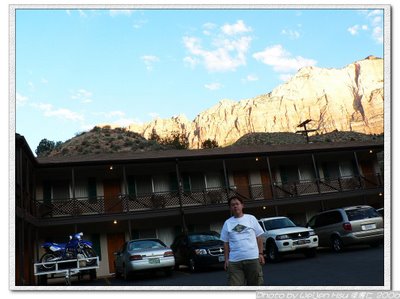
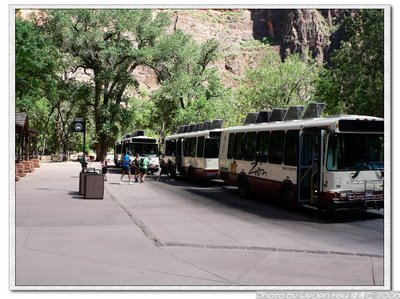

 But as the road wanders up along the cliff, the view into the canyon changes to a downward angle and I could see further from the heights.
But as the road wanders up along the cliff, the view into the canyon changes to a downward angle and I could see further from the heights.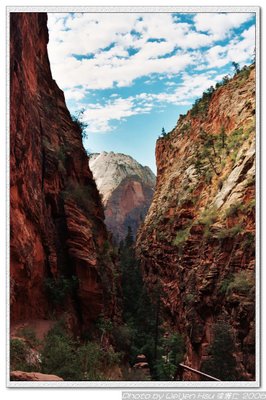 After hiking uphill along the cliff for about 40 minutes, the road took a turn into the cliff and soon the canyon was out of sight temporarily. It was a good morning exercise up to this point, and I enjoyed the nice shape provided by the cliff next to me. I followed the road further down and stood in front of me was the famous Walter's Wiggles.
After hiking uphill along the cliff for about 40 minutes, the road took a turn into the cliff and soon the canyon was out of sight temporarily. It was a good morning exercise up to this point, and I enjoyed the nice shape provided by the cliff next to me. I followed the road further down and stood in front of me was the famous Walter's Wiggles.
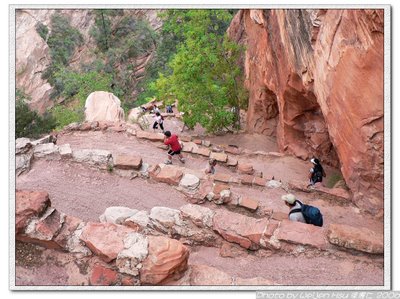
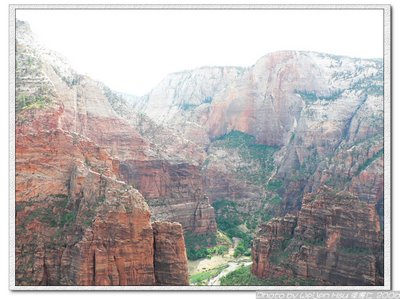
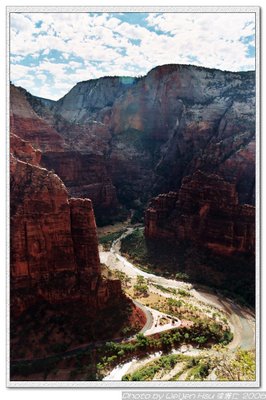
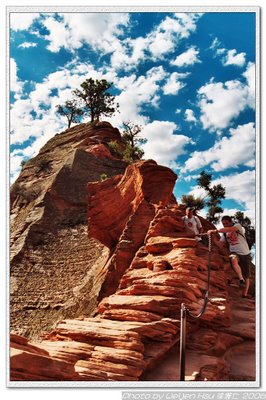
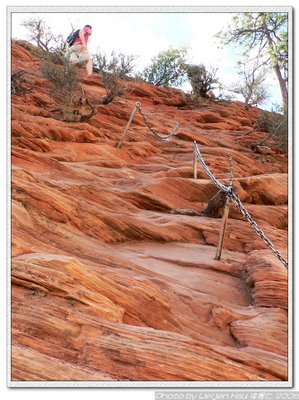 The hike was not easy from this point on. It was especially difficult for me on that day because I was not prepared. I took 2 cameras with me in separate small bags and another handbag for water bottles and my travel guide book. Walking with those was fine, but when I had to keep one hand close to the chains those things became a real burden. I should have used a backpack, I complained to myself. Occasional sharing of the narrow route by two-way traffic made it a bit more challenging. At several points, I was close to the cliff on the side, and there was really nothing in between so I could easily see the thousands of feet drop to the canyon below directly. No wonder they put up a sign to persuade people with aerophobia to turn back.
The hike was not easy from this point on. It was especially difficult for me on that day because I was not prepared. I took 2 cameras with me in separate small bags and another handbag for water bottles and my travel guide book. Walking with those was fine, but when I had to keep one hand close to the chains those things became a real burden. I should have used a backpack, I complained to myself. Occasional sharing of the narrow route by two-way traffic made it a bit more challenging. At several points, I was close to the cliff on the side, and there was really nothing in between so I could easily see the thousands of feet drop to the canyon below directly. No wonder they put up a sign to persuade people with aerophobia to turn back. View of Zion Canyon from Angels Landing, notice that the Zion Lodge (the hotel in Zion NP) is in the middle of the picture.
View of Zion Canyon from Angels Landing, notice that the Zion Lodge (the hotel in Zion NP) is in the middle of the picture. A different view.
A different view.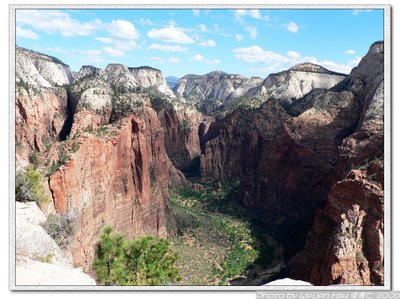 Yet another different angle.
Yet another different angle. My picture at the top of Angels Landing.
My picture at the top of Angels Landing. This poster says it all: from the Walter's Wiggles, to Scout Lookout (in the middle of the poster with a lot of trees), and the walk on the ridge to reach Angels Landing (the top).
This poster says it all: from the Walter's Wiggles, to Scout Lookout (in the middle of the poster with a lot of trees), and the walk on the ridge to reach Angels Landing (the top).

